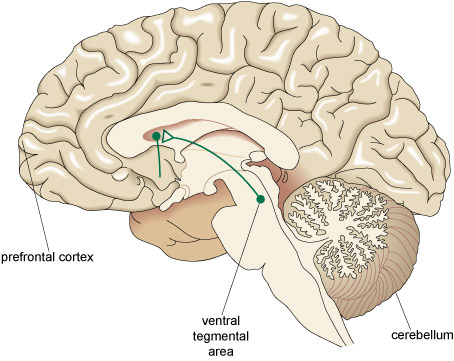1.5 Ethanol and the brain
Despite the fact that ethanol has been consumed for such a long part of human history its effects on the brain are actually quite poorly understood. The brain is a highly complex construction of cells, some of which are known as neurons. Neurons can talk to each other through specific chemicals called neurotransmitters which are used to pass signals from one neuron to another. These chemicals bind to specific proteins called receptors on neighbouring neurons.
ITQ _unit6.1.6
-
Think back to the properties of ethanol discussed in Week 1 – how does ethanol reach the cells of the brain so quickly after drinking an alcoholic drink?
-
Ethanol is highly water-soluble. Given that the bloodstream has a high water content, this means it has a high solubility in the blood, meaning it can be transported rapidly to the cells of the brain.
Upon reaching the cells of the brain, the ethanol can potentially alter mental states, mood and behaviour by interacting with these neurotransmitter receptors. The overall effect of ethanol depends on the activity of the original neurotransmitter. For example, GABA (Gamma-Aminobutyric Acid) is a neurotransmitter that blocks impulses between nerve cells in the brain, and ethanol increases this blocking effect. Ethanol binding to GABA receptors is thought to be responsible for the sedative (sleep-inducing) effects of ethanol. However, the sleep induced by ethanol can be of poorer quality and shorter duration than normal sleep.
In contrast, a specific type of glutamate receptor, referred to as the NMDA receptor (N-methyl-D-aspartate), is known to be critical for learning and memory, and it is excitatory. Ethanol blocks glutamate from binding to NMDA receptors and this is thought to prevent the excitation that is required for learning and memory. This explains the amnesia (loss of memory) that can happen as a result of acute ethanol consumption.
To help consolidate your understanding of the acute actions of ethanol on glutamate and GABA, watch the video below.
Transcript
In addition to the effects of ethanol on GABA and glutamate, ethanol also affects another neurotransmitter called dopamine. Although dopamine’s normal role is in the body’s reward system, it is implicated in addiction. Ethanol increases the activity of neurons that release dopamine as their neurotransmitter – turning up communication by the brain’s reward system. You will learn more about this in Week 7.
Overall, ethanol affects many different brain areas. The three which are of most interest to us in this week are shown in Figure 3.

The region towards the back of the brain, called the cerebellum,is vital in motor coordination, including the ability to balance. Ethanol affects the function of the cerebellum and can disrupt co-ordination. For example, alcohol consumption makes it harder to walk in a straight line and also makes it dangerous to drive a car. The latter is because co-ordination, including that required to react to an obstacle by braking or steering away, is impaired.
In the middle of the brain is a region called the ventral tegmental area (VTA). This region contains neurons that release dopamine into the prefrontal cortex (PFC), which is at the front of the brain. The neurons within the PFC are associated with self-control and restraint. Moderate doses of ethanol selectively depress the activity of these neurons and so people who are intoxicated with ethanol are less restrained. This lack of restraint explains ethanol’s effectiveness as a ‘social lubricant’, but it can also have negative consequences for behaviour.
The lack of restraint induced by ethanol consumption is part of a broader behaviour called alcohol myopia. Myopia means literally ‘short-sightedness’. By analogy with the visual impairment, the term ‘alcohol myopia’ refers to alcohol’s ability to induce a ‘psychological short-sightedness’. It biases an individual’s attention towards their immediate needs and desires and against considering more remote events or the consequences of their actions.
